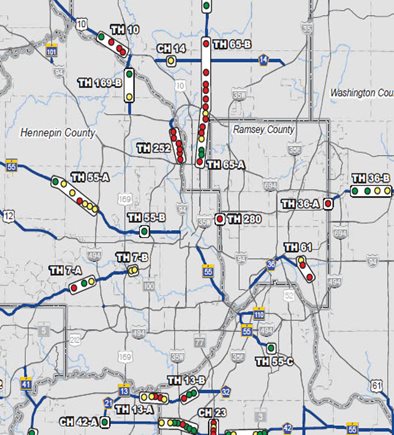The Council and MnDOT worked with regional highway partners to analyze intersections on the non-freeway principal arterial system to identify and prioritize intersections that may be good candidates for conversion to grade-separated facilities - these include designs such as overpasses, interchanges, and other improvements to enhance safety and performance.
Freeways with grade-separated facilities carry traffic faster and in most cases are safer than non-freeway facilities with signalized intersections. Many local agencies and other transportation stakeholders have expressed a desire to pursue state and federal funding to convert some intersections on regional roadways (categorized as principal arterials) to grade-separated facilities to move people and freight more safely.

Study Goals
-
Identify high priority intersections for potential conversion.
-
Use this assignment of priority to assist in project selection for special funding programs such as the federal funds allocated through the Regional Solicitation. There is currently no additional funding specifically set aside for this study’s recommendations.
-
Begin to form short and long-term visions of non-freeway principal arterial corridors and intersections.
- Assist in better understanding at a high level the costs associated with these projects to help in prioritizing investments for these types of project in the future transportation plans.
The study focused on roadways that are priorities for grade separations, and categorized specific locations into low, medium, or high investment priorities for conversion to grade separation. The study also examined other lower-cost and potentially higher return-on-investment improvements that could enhance safety and performance of the roadway without grade separations.
Results
-
Of the 91 intersections studied in the project’s second phase, 34 were categorized as high-priority for grade-separation. The high-priority intersections often exhibit needs that can justify high-capacity at-grade improvements or grade-separation. These intersection locations (and the corridors they are within) should be addressed in more detail to determine the right-sized investments.
-
27 intersections studied in the second phase were categorized as medium-priority for grade-separation. The medium-priority intersections typically do not need grade-separation projects based on current demand. However, additional studies at these locations could show needs for high-capacity at-grade improvements or limited/emerging needs for grade-separated elements.
-
The remaining 30 intersections studied were categorized as low-priority for grade-separation. These locations generally do not need major changes or projects based on current demand and any problems can most likely be addressed with at-grade projects. However, some low-priority intersections are located on corridors near medium- and high-priority intersections or may be in growth areas.
Final Report
Next Steps
The study supports future local planning, the Transportation Policy Plan, the State Highway Investment Plan, and related regional and state funding programs. The work will also guide analysis to right-size proposed projects and provide background for related initiatives. Updates are expected every four to eight years.